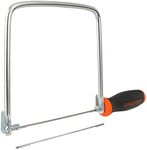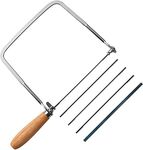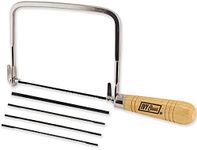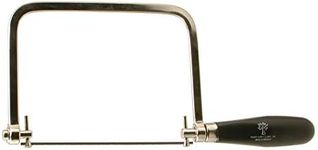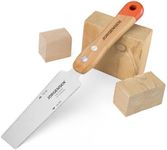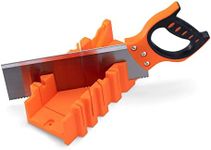Buying Guide for the Best Coping Saws
Choosing the right coping saw can make a significant difference in your woodworking projects. A coping saw is a type of hand saw used to cut intricate external shapes and interior cut-outs in woodworking or carpentry. It's particularly useful for cutting curves and detailed shapes. To find the best coping saw for your needs, you should consider several key specifications. Understanding these specs will help you make an informed decision and ensure that the saw you choose is the best fit for your projects.Blade TypeThe blade type is crucial because it determines the kind of cuts you can make. Coping saw blades come in various tooth configurations, such as fine or coarse. Fine-toothed blades are ideal for detailed and delicate work, while coarse-toothed blades are better for faster, rougher cuts. If you plan to work on intricate designs, opt for a fine-toothed blade. For general-purpose cutting, a medium-toothed blade is a good compromise.
Blade LengthBlade length affects the depth of cut you can achieve. Standard coping saw blades are typically around 6.5 inches long. A longer blade allows for deeper cuts, which is useful for larger projects. However, a shorter blade can provide more control for detailed work. Consider the size of the projects you will be working on to determine the appropriate blade length.
Frame DepthThe frame depth, or throat depth, is the distance from the blade to the back of the frame. This determines how far into the material you can cut. Frames usually range from 4 to 6 inches in depth. A deeper frame allows for more versatility in cutting larger pieces, while a shallower frame offers better control for smaller, more detailed work. Choose a frame depth based on the typical size of your projects.
Tensioning MechanismThe tensioning mechanism is what keeps the blade taut and stable during use. A good tensioning mechanism ensures that the blade does not wobble, which can affect the accuracy of your cuts. Some coping saws have a simple wing nut for tensioning, while others have more sophisticated mechanisms. If precision is important for your work, look for a saw with a reliable and easy-to-use tensioning system.
Handle ComfortHandle comfort is important because it affects how long you can use the saw without fatigue. Coping saw handles come in various shapes and materials, such as wood or plastic. An ergonomic handle that fits well in your hand can make a big difference in comfort and control. If you plan to use the saw for extended periods, prioritize a handle that feels comfortable and secure.
Blade SwivelingBlade swiveling refers to the ability to rotate the blade within the frame. This feature allows you to make cuts at different angles without having to reposition the material. Some coping saws offer 360-degree swiveling, which is ideal for intricate and curved cuts. If your projects involve a lot of detailed work, a saw with a swiveling blade can be very beneficial.
